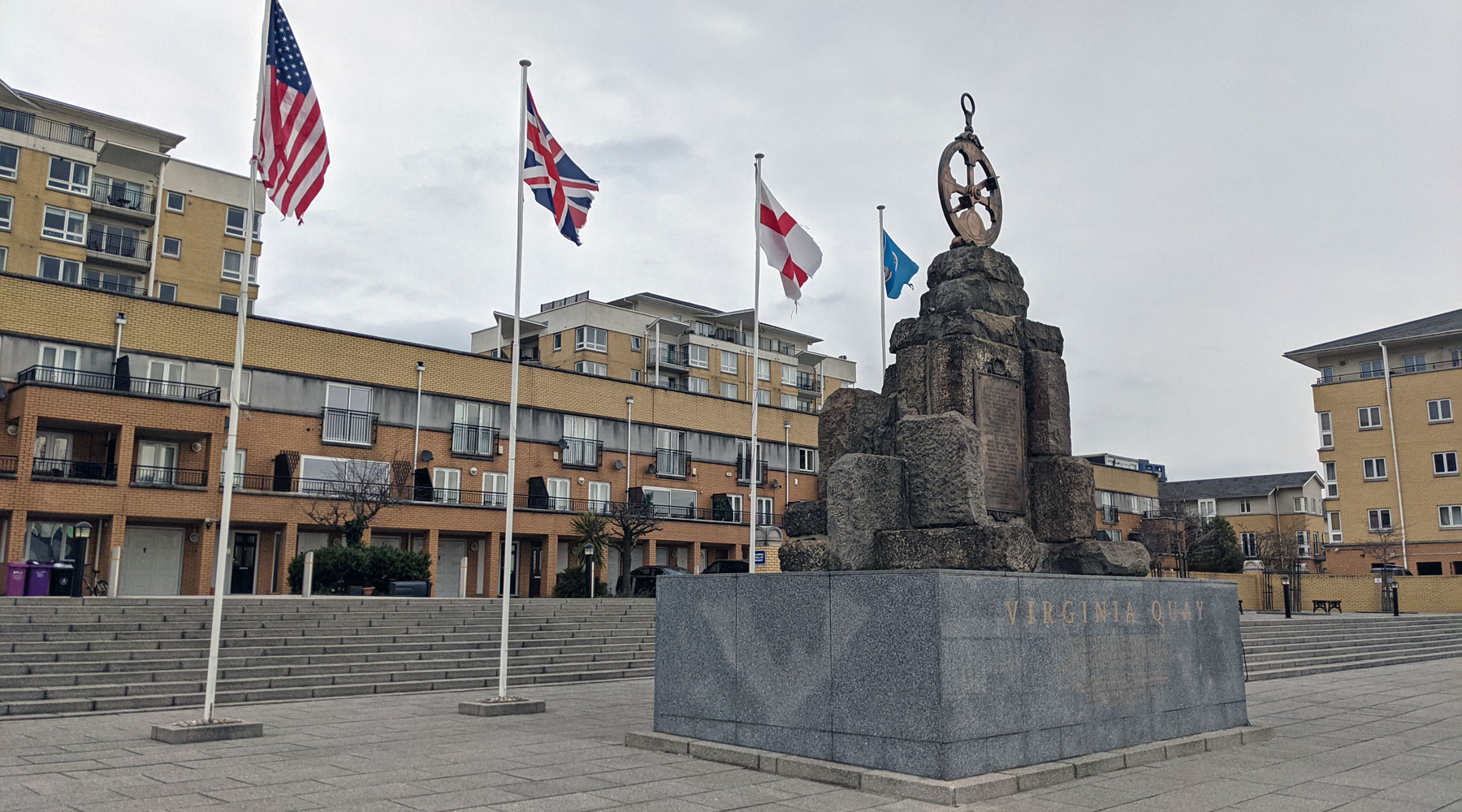A huge monument to the original English settlers of the USA stands proud overlooking the Thames, and is surprisingly unlikely for you to casually walk past.
The Virginia Quay Settlers Monument marks the spot, roughly, where the first of the settlers of the new London Company set out in 1606, with the authorisation of King James I to set up colonies in the new land.
Many people think the Mayflower voyage of 1620 was the first English settlement, but it wasn’t, and most of what you’ve probably heard about that voyage and their Thanksgiving dinner is also largely a later fiction invented by a young nation seeking a founding myth.
But back a few years, and in 1606, the London Company was created as for-profit expedition to establish a settlement in the Virginia territory. The expedition consisted of three ships, which set sail on December 20, 1606 from Blackwall, with 105 men and boys and 39 crew-members
They took the long way round, taking nearly 21 weeks (the Mayflower took 10 weeks) to find land suitable for a settlement, Jamestown. Unfortunately, most of the seafarers were not really the sort of people you would send on such a mission, being mostly gentlemen unused to work, and gentlemen’s staff unused to farming. Starvation ensued.
Within 3-years, the settlement was abandoned, and although later reoccupied, it didn’t last long and was abandoned again in 1699. Today nothing survives apart from architectural discoveries, and a tourist industry.
Although not as famous today as the later Mayflower settlement, Jamestown’s greatest claim to fame amongst most people is that one of its settlers was Captain Smith, who (allegedly) had his life saved by the native Indian, Pocahontas. She later married John Rolfe and came to England, but died in 1617 and is buried in Gravesend.
But back to London…
In 1928, the Society for the Protection of West Virginia Artefacts donated a bronze plaque that was attached to the nearby Blackwall Quay dockmaster’s house to mark the spot where the three ships left London.
That house was destroyed in WW2, but the plaque recovered, and in 1951 it was mounted on a new large stone monument, with a bronze mermaid by the Hamstead based sculptor Harold Brown on top, and unveiled by the US Ambassador, Walter Gifford. The stone was granite hewn from the old dock walls in the area.
The mermaid was later stolen, leaving just the pile of stone and the plaque.
Jumping forward to 1999, and the London Docklands Development Corp (LDDC) is busy restoring the area, and the housing developer responsible for all the blocks of flats in the area paid for the monument’s restoration, on a new large stone plinth. It was unveiled in its new home by the US Ambassador, Philip Lader.
Where there had been a mermaid, there is now a mariners’ astrolabe, by the sculptor Wendy Taylor CBE.
Incidentally, the stolen mermaid later turned up at an auction in 2007.
The original bronze plaque reads:
FROM NEAR THIS SPOT/DECEMBER 19 1606/SAILED WITH “105 ADVENTURERS”/THE “SUSAN CONSTANT” 100 TONS/CAPT CHRISTOPHER NEWPORT/IN SUPREME COMMAND/THE “GODSPEED” 40 TONS/CAPT BARTHOLOMEW GOSNOLD/THE “DISCOVERY” 20 TONS/CAPT JOHN RATCLIFFE/LANDED AT CAPE HENRY VIRGINIA/ APRIL 1607/ARRIVED AT JAMESTOWN VIRGINIA/MAY 13 1607/WHERE THESE “ADVENTURERS”/FOUNDED THE FIRST PERMANENT/ENGLISH COLONY IN AMERICA/UNDER THE LEADERSHIP OF THE/INTREPID CAPT JOHN SMITH/EDWARD MARIA WINGFIELD/PRESIDENT OF THE COUNCIL/THE REVEREND ROBERT HUNT/AND OTHERS/AT JAMESTOWN JULY 30 1619 WAS/CONVENED THE FIRST ASSEMBLY IN AMERICA.
The newer granite base reads:
VIRGINIA QUAY/THE VIRGINIA SETTLERS MEMORIAL TABLET WAS/UNVEILED IN 1928 ON THE WALL/OF BRUNSWICK HOUSE WHICH FORMERLY STOOD/ABOUT 100 YARDS TO THE WEST OF THIS POINT/IN 1999 BARRATT HOMES LIMITED REINSTATED/THIS MONUMENT AND COMMISSIONED THE MARINERS ASTROLABE/BY WENDY TAYLOR C.B.E.
The reason why it’s not that well known as a monument is that it’s on a part of the Thames Path that’s not obvious to find, and indeed if you don’t know about it quite likely would never stumble upon the location.
The easiest way to find it is to get to East India DLR, then cross the road to the corner shop and head towards the river – then turn left and you will find it there. The plaza is sometimes a dead-end, as it leads to East India Dock, which is a delight to wander around, when the gates are open.
And that’s why other than locals and committed explorers, it’s not a well-known monument.
For the railway geeks, the houses behind the monument are on the site of the old Blackwall Railway Station, which was open from 1840 to 1926, and demolished in 1946.










Yep, bumped into this by accident a few months ago!!
And right next to East India Dock bird sanctuary, a salt marsh environment visited by all sorts of lovely species. My favourite place within 20 mins walk of Docklands
There is another intriguing aspect to the Jamestown saga.
A very large relief convoy was dispatched in 1609, but things didn’t go well – it hit a hurricane. The flagship, the Sea Venture, was shipwrecked on Bermuda, previously uninhabited, which turned out to be a major stroke of good fortune, with all sorts of unexpected consequences – it was the inspiration for ‘The Tempest’.
https://encyclopediavirginia.org/entries/sea-venture/
There was an even earlier English settlement, at Roanoke, but all the settlers there just vanished. The Jamestown ones didn’t vanish, they moved to found Williamsburg, which is still there and a big tourist attraction. They’d been told to steer clear of the natives and not get into fights, so they initially settled by the James River. There was a reason why no Indians lived there: it was malarial; that’s why the settement had to be abandoned.
Having said all that, the Spanish settlement at St Augustine in Florida is much older.